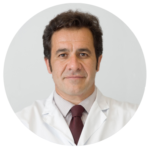4 March, 2022
The Clinic is a pioneer in Spain in the extraction of tumours from the base of the skull through the eye

In recent years, surgery has developed enormously to achieve increasingly less invasive interventions. Achieving the same results as traditional open surgeries, these new approaches achieve a faster recovery for patients and minimize the risks of operations, which is why their use is becoming more and more widespread. Now, the Hospital Clínic Group has begun to perform surgeries through the eye to remove tumours from the base of the skull, becoming the first centre in Spain to perform transorbital neuroendoscopic surgery and one of the few in the rest of the world to use it.
“This technique is a clear example of an innovation project that we carry out at the Hospital Clínic de Barcelona. It allows us to be much more efficient in surgery and provide better benefit and recovery for patients”, explains Dr Joaquim Enseñat, head of the Neurosurgery Service at Hospital Clínic and barnaclínic+ professional, who leads the multidisciplinary team in charge of carrying out these new interventions. With this new approach, a total of 20 surgeries have already been performed at the Hospital Clínic, and the data obtained has served to publish an article in the Journal of Neurosurgery.
«This technique is a clear example of an innovation project that we carry out at the Hospital Clínic de Barcelona. It allows us to be much more efficient in surgery and provide a better benefit and recovery for patients»
Dr Joaquim Enseñat, neurosurgeon
IT MAY INTEREST YOU…
– What are skull base tumors?
A SMALLER INCISION FOR FEWER COMPLICATIONS
Transorbital neuroendoscopic surgery is performed through the eye socket. This avoids having to perform a craniotomy – an operation in which a piece of the skull is removed – to access the brain. This avoids having to make a larger incision, with the possible complications associated with it. On some occasions, the process of extracting tumours from the base of the skull can also be combined through the nose.
Dr Isam Alobid, coordinator of the multidisciplinary unit of Skull Base Surgery at the Hospital Clínic, otolaryngologist at barnaclínic+ and another of the professionals who forms part of the multidisciplinary team headed by Dr Enseñat, comments that “Transorbital neuroendoscopic surgery is a minimally invasive surgery that aims to remove the tumour from the base of the skull while respecting the vital structures and the physiology of the nose”.
«Transorbital neuroendoscopic surgery is a minimally invasive technique that aims to remove the skull base tumour while respecting the vital structures and physiology of the nose»
Dr Isam Alobid, ENT surgeon
With this technique, the surgery time is much shorter, since the skull does not have to be repaired and a large incision does not need to be closed. This approach also allows repairs to be made without lifting the brain, protecting the optic and olfactory nerves, as well as the carotid and ophthalmic arteries. Additionally, benefits of this transorbital approach include reduced pain and decreased recovery time for the patient.
To gain access, the surgical team makes a small incision in the upper margin of the eyelid. A small hole is then made through the bones of the orbits, only two or three centimetres, until reaching the brain. Dr Juan Carlos Sánchez España, oculoplastic surgeon at the Clinic Institute of Ophthalmology and barnaclínic+, also one of the professionals involved in this new surgery, explains that “the orbit is a strategically located structure of the skull since it is a bone corridor directly connected to the brain. It is necessary to handle it carefully to avoid possible complications at the ophthalmological level”.
«The orbit is a strategically located structure of the skull since it is a bony corridor with a direct connection to the brain. It is necessary to handle it carefully to avoid possible complications at the ophthalmological level»
ADVANTAGES OF THE NEW APPROACH AND INDICATIONS
Surgery time is much shorter, as the skull does not need to be repaired and a large incision does not need to be closed. This approach also allows repairs to be made without lifting the brain, protecting the optic and olfactory nerves, as well as the carotid and ophthalmic arteries. Additionally, benefits of this transorbital approach include reduced pain and decreased recovery time for the patient.
WHAT IS TRANSORBITAL NEUROENDOSCOPIC SURGERY USED FOR?
The transorbital neuroendoscopic surgery procedure has been used to repair cerebral spinal fluid leaks, decompression of the optic nerve, repair of basilar skull fractures, and removal of tumours. The base of the skull is the area from between the eyes, behind the nose, to the brain and spinal cord. It is one of the most complex areas of human anatomy as multiple nerves as well as major blood vessels to the brain, head, and neck pass through it. Skull base tumours are rare, affecting less than 1/100,000 people per year. They are histologically a diverse group of tumors and potentially pose management problems due to their proximity to the orbit and intracranial cavity.
This technique is especially indicated for patients with a tumour in the central part of the skull base, but somewhat laterally, in the cavernous system, in the medial part of the temporal lobe or in lateral tumours in the third cranial nerve. The team of professionals from the Hospital Clínic group began by testing this technique on cadavers before putting it into practice with patients.
DO YOU WANT MORE INFORMATION ABOUT THIS TECHNIQUE OR DO YOU WANT TO CONTACT OUR EXPERT PROFESSIONALS IN THE APPROACH TO SKULL BASE TUMOURS?
Image: Francisco Avia – Hospital Clínic




 «The orbit is a strategically located structure of the skull since it is a bony corridor with a direct connection to the brain. It is necessary to handle it carefully to avoid possible complications at the ophthalmological level»
«The orbit is a strategically located structure of the skull since it is a bony corridor with a direct connection to the brain. It is necessary to handle it carefully to avoid possible complications at the ophthalmological level»